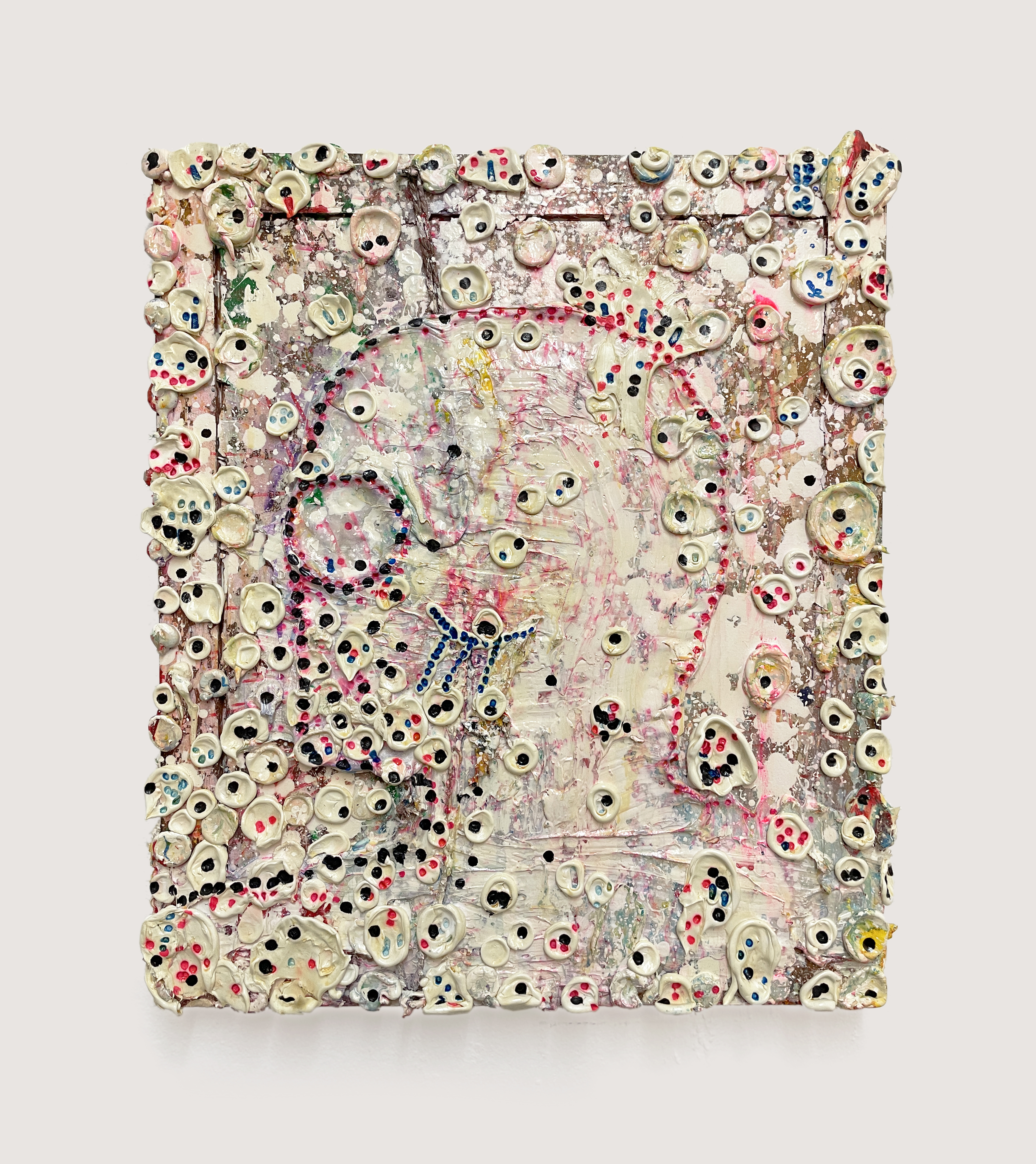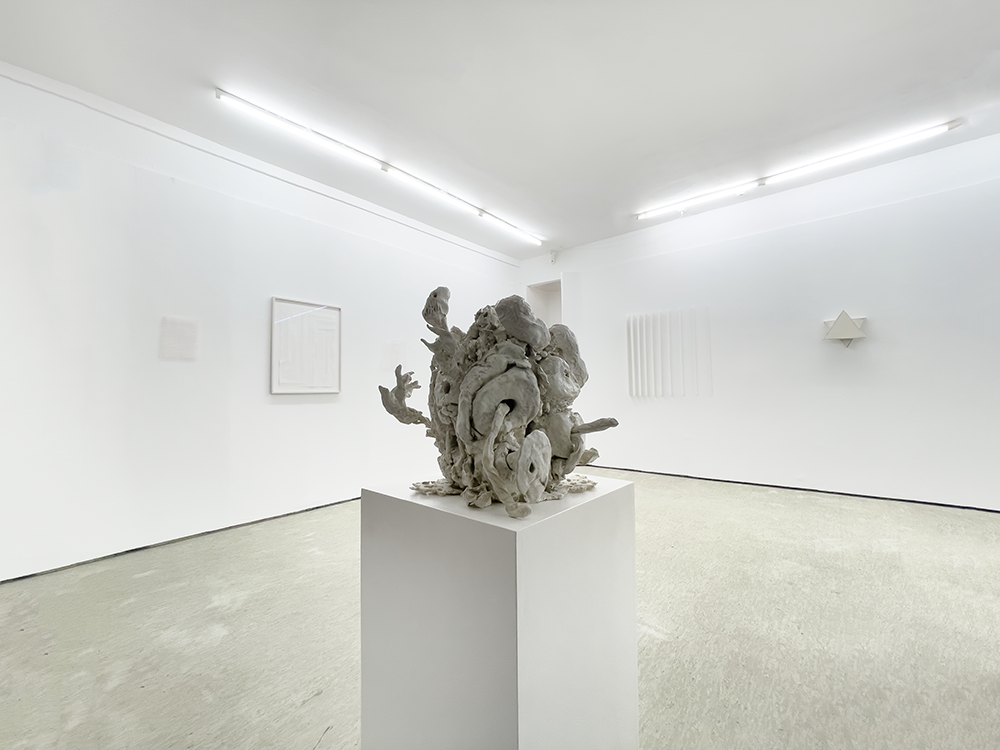Allan Bestle, Cécile Dupaquier, Daan Lievense, Dennis Feddersen, Fiene Scharp, Jens Wolf, Kai Richter, Kirsten Hutsch, Markus Wüste, Simon Schubert, Sophia Schama: White : Verena Kerfin Gallery, Köthener Strasse 28, 10963 Berlin
Past
exhibition
Overview
Under the curatorial direction of Jeroen Cremers, artists have gathered around an almost metaphysical theme „White“ and will present in the exhibition from April 19th to May 17th, 2024, in the Verena Kerfin Gallery, that reduction is not a limitation but rather resembles a consolidation, a contemplation on the essence of art.
In 1910, Wassily Kandinsky noted in his Poetics of Spiritual Art: „When more closely defined, white, often considered a non-color, is like a symbol of a world where all colors, as material properties and substances, have disappeared. This world is high above us, so that we hear no sound from there. There comes a great silence from there, materially depicted like an insurmountable, indestructible, infinitely cold wall.
Therefore, white also acts on our psyche as a great silence, which is absolute for us. It sounds inwardly like a non-sound, which corresponds quite well to some pauses in music, the pauses that only temporarily interrupt the development of a phrase or content and are not a defined conclusion of a development. It is a silence that is not dead, but full of possibilities. White sounds like silence that can suddenly be understood. It is a nothingness that is youthful, or more precisely, a nothingness that is before the beginning, before birth.“
It is important to understand that the phenomenological appearance of white must be strictly separated from its associative interpretation. The perception of white is not equivalent to the associations it can evoke in the viewer. Newton demonstrated through experiments with prisms that white light encompasses the entire spectrum of colors, ranging from red through yellow, green, blue to violet, when projected onto a white surface. He then showed that passing this spectrum through a lens could produce white or colorless light again. This proved that white light can be composed of the colors of the rainbow.
However, the causes of color perception are not solely physiological. Ultimately, the brain determines the impression of color that we receive. The physical stimulus on our retinas is not always decisive, as color also leaves a psychological imprint on individuals.
Color meanings are organized in a consistent scheme, with most colors associated with specific ideas, emotions, and impressions. However, white stands out as a color with a rich history and a variety of connotations.
Psychological studies often attribute terms like „ideal,“ „perfect,“ and „good“ to white and associate it with purity and innocence. Both optical experience and inner perception recognize white as the purest sensory perception of all colors. This leads to further aspects of white such as purity, innocence, and chastity, which are often directly associated with the color.
However, white can also carry negative associations. Due to its qualities as untouchable and transcendent, white often appears inaccessible and perfect, leading to associations with sacrificial and mourning cults. Furthermore, white is negatively connoted in ghost stories and malevolent magic.
In the Christian tradition, white symbolizes the untouchable. Nowadays, white is often equated with religious thoughts like piety and faith. The church has used this symbol for centuries to solidify consolidate the importance of white. Therefore, it is not surprising that white plays a significant role in Christian art, especially as the color of garments worn by heavenly beings such as angels and saints.
In the Bible white is associated with the radiance of light and symbolizes purity and innocence. Although the Bible is somewhat „color-averse“ and has no word for „color,“ white is frequently used in texts to represent the divine and the true. The depiction of God the Father and the resurrected Christ with white hair and garments underscores the symbolic significance of white in the Bible.
Overall, white encompasses a variety of meanings and interpretations that are heavily influenced by cultural, religious, and historical contexts. White is not only rarely cited as a favorite color but is also often negatively connoted. However, it is often mentioned as the first positive color, especially when asked about positive feelings.
White is also appreciated for its functional and pragmatic qualities. The abstraction of color leads to a theoretical view of the world that requires consciousness, self-awareness, and a certain irony. However, color escapes a purely theoretical interpretation more than any other visual element.
Sociological, ideological, and cultural contexts inevitably shape access to works of art. Existing expectations influence interpretation. The white monochrome frees painting from articulation and reduces it to a formal schematism that allows minimal distraction and focuses on the interaction between structured surfaces and light.
Despite their apparent emptiness, white monochrome works can be laden with content, as can be seen in the works of Malevich and Fontana. They offer the opportunity to engage with material qualities and an unconstrained color concept.
Color requires the fundamental involvement of the observer and defies a purely theoretical interpretation. The optical analysis of an artwork enables an authentic understanding of color painting. The integration of information about the artist and his surroundings can deepen the understanding of a work of art, whereby traditional knowledge about the meaning of color plays a crucial role.
Overall, white allows for a variety of interpretations and opens up a subtle reception process for the viewer.
In 1910, Wassily Kandinsky noted in his Poetics of Spiritual Art: „When more closely defined, white, often considered a non-color, is like a symbol of a world where all colors, as material properties and substances, have disappeared. This world is high above us, so that we hear no sound from there. There comes a great silence from there, materially depicted like an insurmountable, indestructible, infinitely cold wall.
Therefore, white also acts on our psyche as a great silence, which is absolute for us. It sounds inwardly like a non-sound, which corresponds quite well to some pauses in music, the pauses that only temporarily interrupt the development of a phrase or content and are not a defined conclusion of a development. It is a silence that is not dead, but full of possibilities. White sounds like silence that can suddenly be understood. It is a nothingness that is youthful, or more precisely, a nothingness that is before the beginning, before birth.“
It is important to understand that the phenomenological appearance of white must be strictly separated from its associative interpretation. The perception of white is not equivalent to the associations it can evoke in the viewer. Newton demonstrated through experiments with prisms that white light encompasses the entire spectrum of colors, ranging from red through yellow, green, blue to violet, when projected onto a white surface. He then showed that passing this spectrum through a lens could produce white or colorless light again. This proved that white light can be composed of the colors of the rainbow.
However, the causes of color perception are not solely physiological. Ultimately, the brain determines the impression of color that we receive. The physical stimulus on our retinas is not always decisive, as color also leaves a psychological imprint on individuals.
Color meanings are organized in a consistent scheme, with most colors associated with specific ideas, emotions, and impressions. However, white stands out as a color with a rich history and a variety of connotations.
Psychological studies often attribute terms like „ideal,“ „perfect,“ and „good“ to white and associate it with purity and innocence. Both optical experience and inner perception recognize white as the purest sensory perception of all colors. This leads to further aspects of white such as purity, innocence, and chastity, which are often directly associated with the color.
However, white can also carry negative associations. Due to its qualities as untouchable and transcendent, white often appears inaccessible and perfect, leading to associations with sacrificial and mourning cults. Furthermore, white is negatively connoted in ghost stories and malevolent magic.
In the Christian tradition, white symbolizes the untouchable. Nowadays, white is often equated with religious thoughts like piety and faith. The church has used this symbol for centuries to solidify consolidate the importance of white. Therefore, it is not surprising that white plays a significant role in Christian art, especially as the color of garments worn by heavenly beings such as angels and saints.
In the Bible white is associated with the radiance of light and symbolizes purity and innocence. Although the Bible is somewhat „color-averse“ and has no word for „color,“ white is frequently used in texts to represent the divine and the true. The depiction of God the Father and the resurrected Christ with white hair and garments underscores the symbolic significance of white in the Bible.
Overall, white encompasses a variety of meanings and interpretations that are heavily influenced by cultural, religious, and historical contexts. White is not only rarely cited as a favorite color but is also often negatively connoted. However, it is often mentioned as the first positive color, especially when asked about positive feelings.
White is also appreciated for its functional and pragmatic qualities. The abstraction of color leads to a theoretical view of the world that requires consciousness, self-awareness, and a certain irony. However, color escapes a purely theoretical interpretation more than any other visual element.
Sociological, ideological, and cultural contexts inevitably shape access to works of art. Existing expectations influence interpretation. The white monochrome frees painting from articulation and reduces it to a formal schematism that allows minimal distraction and focuses on the interaction between structured surfaces and light.
Despite their apparent emptiness, white monochrome works can be laden with content, as can be seen in the works of Malevich and Fontana. They offer the opportunity to engage with material qualities and an unconstrained color concept.
Color requires the fundamental involvement of the observer and defies a purely theoretical interpretation. The optical analysis of an artwork enables an authentic understanding of color painting. The integration of information about the artist and his surroundings can deepen the understanding of a work of art, whereby traditional knowledge about the meaning of color plays a crucial role.
Overall, white allows for a variety of interpretations and opens up a subtle reception process for the viewer.
Installation Views
×
![]()
Works
-
 Dennis FeddersenUntitled (1000 Plateaus), 2022
Dennis FeddersenUntitled (1000 Plateaus), 2022 -
 Cécile DupaquierArchiv (Disappearance), 2021
Cécile DupaquierArchiv (Disappearance), 2021 -
 Kirsten HutschInventory Studio Kruitberg, Everything from the Floor Up, 2024
Kirsten HutschInventory Studio Kruitberg, Everything from the Floor Up, 2024 -
 Daan LievenseBirdhouse Banana, 2013
Daan LievenseBirdhouse Banana, 2013 -
 Kai RichterWeiße Säule, 2021
Kai RichterWeiße Säule, 2021 -
 Kai RichterWhite star, 2024
Kai RichterWhite star, 2024 -
 Sophia SchamaJ 14124, 2024
Sophia SchamaJ 14124, 2024 -
Fiene ScharpUntitled (Fs 01 197), 2024
-
Fiene ScharpUntitled (Fs 01 198), 2024
-
Fiene ScharpUntitled (Fs 01 200), 2024
-
 Fiene ScharpUntitled (Fs 01 199), 2024
Fiene ScharpUntitled (Fs 01 199), 2024 -
 Simon SchubertUntitled (Nesting and Light), 2024
Simon SchubertUntitled (Nesting and Light), 2024 -
 Jens WolfUntitled (18.11), 2018
Jens WolfUntitled (18.11), 2018 -
 Allan BestlePoison 2, 2023
Allan BestlePoison 2, 2023 -
 Dennis FeddersenAnd what am I, that I am here?, 2022
Dennis FeddersenAnd what am I, that I am here?, 2022 -
 Dennis FeddersenMentalgefäss #2, 2022
Dennis FeddersenMentalgefäss #2, 2022
×

















